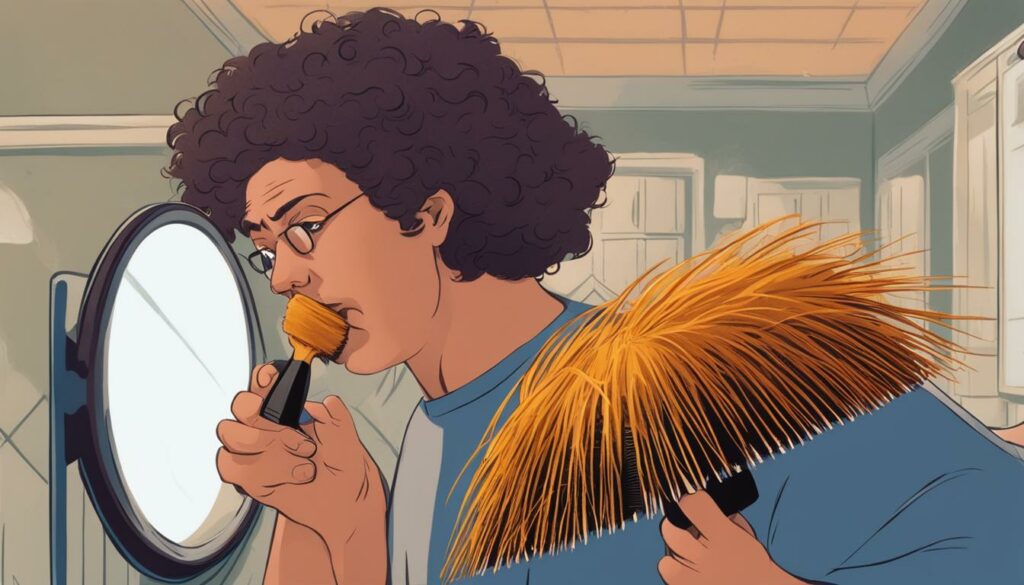Struggling with damaged hair that feels dry, brittle, and lifeless? Don’t worry; damaged hair can be repaired and revived with the right treatment regimen. This section will explore the common causes of damaged hair and provide expert tips and techniques for repairing and restoring your locks.
Damaged hair can result from various factors, including bleaching, heat styling, and hair color treatments. Bleaching can strip away moisture and leave hair dry and brittle, while excessive use of heat styling tools can lead to dryness, breakage, and dullness. Hair color treatments may also strip away moisture and cause breakage. By understanding the causes, you can take preventive measures to protect your hair from further damage.
To repair damaged hair, it’s crucial to adopt a comprehensive hair care routine. Start by using a quality shampoo and conditioner that are formulated for damaged hair. Wash your hair with lukewarm water, as hot water can strip away essential oils. Deep conditioning treatments can provide much-needed moisture and nourishment to your hair. Use a wide-tooth comb to gently detangle your hair and minimize breakage.
Consider incorporating leave-in conditioner into your routine to provide ongoing hydration. Embrace heatless hairstyles, such as braids or buns, to give your hair a break from styling tools. Getting regular trims will help eliminate split ends and promote healthy hair growth.
In addition to these practices, using a silk or satin pillowcase can help prevent friction and reduce damage while you sleep. Applying natural remedies, such as coconut oil or aloe vera, can provide extra nourishment and restore your hair’s vitality.
Remember, damaged hair requires patience and consistency in your hair care routine. With a little extra care and the right treatment, you can revitalize your locks and restore them to their former glory.
**Key Takeaways:**
– Damaged hair can be caused by bleaching, heat styling, and hair color treatments.
– Preventive measures, such as using a quality shampoo and conditioner, washing with lukewarm water, and avoiding excessive heat, can help protect your hair from further damage.
– Deep conditioning, using a wide-tooth comb, and incorporating leave-in conditioner are effective ways to repair damaged hair.
– Embracing heatless hairstyles and regular trims can promote healthy hair growth.
– Using a silk or satin pillowcase and applying natural remedies can provide additional nourishment for damaged hair.
Causes of Damaged Hair
Are you wondering what may be causing your hair to become dry, brittle, and lifeless? Understanding the causes of damaged hair is the first step towards restoring its health and vitality. Let’s take a closer look at some common culprits:
Bleaching
One of the major causes of damaged hair is bleaching. While bleaching can give you a trendy and vibrant hair color, it can also strip away moisture and leave your hair dry and brittle. The chemicals used in the bleaching process can weaken the hair’s structure, making it more prone to breakage. If you frequently bleach your hair, it’s important to take extra care to nourish and moisturize it.
Heat Styling
Excessive use of heat styling tools like flat irons, curling irons, and blow dryers can also cause significant damage to your hair. The high temperatures from these tools can remove moisture from your hair strands, leaving them dry, brittle, and prone to breakage. Additionally, heat styling can result in dullness and frizz. It’s essential to use heat protectants and minimize heat styling to prevent further damage.
Hair Color Treatments
Do you frequently change your hair color? While experimenting with different shades can be fun, it can also damage your hair. Hair color treatments, especially those that involve bleach or harsh chemicals, can strip away the natural oils and moisture from your hair, leading to dryness, breakage, and overall hair damage. To minimize the impact of hair color treatments, consider opting for more gentle, nourishing options. Always follow up with deep conditioning and moisturizing to restore vitality.
Preventing Hair Damage
To prevent further damage to your hair, it’s important to take preventive measures. Here are some tips:
- Limit the use of heat styling tools and always apply a heat protectant before using them.
- Choose hair color treatments that are less damaging and use nourishing hair masks to restore moisture.
- Avoid over-washing your hair and use lukewarm water instead of hot water.
- Trim your hair regularly to get rid of split ends and promote healthy hair growth.
- Opt for hairstyles that don’t require excessive heat or tension on the hair.
- Use a wide-tooth comb or a detangling brush to minimize breakage when styling or detangling your hair.
By understanding the causes of damaged hair and taking proactive steps to prevent further damage, you can restore your hair’s health and vitality. Now that we know the common causes, let’s dive into effective hair treatments for damaged hair in the next section.
Hair Treatment for Damaged Hair
Repairing damaged hair requires a combination of effective hair treatment practices and targeted treatments. By incorporating these essential tips into your hair care routine, you can restore and revitalize your locks. Let’s explore the key components of an effective hair treatment for damaged hair:
1. Quality Shampoo and Conditioner
Start with a good foundation by using a quality shampoo and conditioner specifically designed for damaged hair. Look for products that are enriched with nourishing ingredients like keratin, argan oil, or shea butter to help replenish moisture and strengthen your hair.
2. Lukewarm Water
When washing your hair, opt for lukewarm water instead of hot water. Hot water strips away natural oils and can further dry out and damage your hair. Rinse with cool water at the end of your shower to help seal the hair cuticles and promote shine.
3. Deep Conditioning
Deep conditioning treatments provide intense hydration and nourishment to your damaged hair. Choose a deep conditioning mask or treatment that is specifically formulated to repair and restore your hair’s health. Leave the treatment on for the recommended time to allow the ingredients to penetrate the hair shaft and provide optimal benefits.
4. Wide-Tooth Comb
When detangling your hair, use a wide-tooth comb instead of a brush. This helps minimize breakage and prevents further damage to your fragile strands. Start from the ends and work your way up, being gentle and patient as you remove knots and tangles.
5. Leave-In Conditioner
Applying a leave-in conditioner to your hair after washing can provide continued moisture and protection throughout the day. Look for leave-in conditioners that contain ingredients like coconut oil, aloe vera, or silk proteins to nourish and strengthen your damaged hair.
6. Embrace Heatless Hairstyles
Give your hair a break from heat styling tools and embrace heatless hairstyles. Experiment with braids, buns, or twists to create beautiful, damage-free looks. This allows your hair to recover and regain its natural texture and strength.
7. Regular Trims
Trimming your hair regularly helps remove split ends and prevents them from traveling up the hair shaft, causing further damage. Aim for a trim every 6-8 weeks to keep your hair healthy and manageable.
8. Silk or Satin Pillowcase
Swap out your cotton pillowcase for a silk or satin one. These materials create less friction against your hair, reducing breakage and frizz while you sleep. Additionally, they help retain moisture and prevent your hair from drying out overnight.
By following these hair treatment practices and incorporating targeted treatments into your routine, you can effectively repair and rejuvenate your damaged hair. Consistency and patience are key, and soon you’ll be on your way to healthy, lustrous locks.
Refreshing Hair Without Washing
Sometimes, you need a quick fix to refresh your hair between washes. Whether you’re short on time or simply want to minimize the need for frequent washing, these effective techniques will help maintain a fresh appearance. Let’s explore how you can refresh your hair without washing.
- Dry Shampoo: One of the go-to options for refreshing hair without washing is dry shampoo. This convenient spray absorbs excess oil and adds volume to your roots, giving your hair a cleaner and fresher look. Simply spray it onto your roots, wait a few minutes, and then brush it out. Voila!
- Choosing the Right Brush: Using the right brush is key when refreshing your hair. Opt for a paddle brush or a boar bristle brush to distribute the oils throughout your hair, providing a natural shine and a refreshed appearance.
- Managing Frizz: To combat frizz and maintain a polished look, try using a lightweight leave-in conditioner or a smoothing serum. Gently run it through your hair, paying extra attention to the ends. This will help tame frizz and add shine.
- Adding Movement: Don’t be afraid to switch up your hairstyle to add movement to your hair. Try loose waves, a messy bun, or a high ponytail to give your hair a new lease of life.
- Letting Your Shampoo Wait: When you’re short on time, but your hair needs a little pick-me-up, try extending the time between washes. Allow your shampoo to wait a day or two, as this can help your scalp produce natural oils that will refresh your hair.
By incorporating these techniques into your hair care routine, you can keep your locks looking fresh and fabulous, even on those non-wash days.

Adding refreshment to your hair doesn’t always require a full washing routine. Dry shampoo, the right brush, and managing frizz are just a few ways to breathe new life into your locks. By choosing the right techniques, you can maintain a fresh appearance while minimizing the need for frequent washing. Let your hair shine with a quick refresh!
Choosing the Right Brush
When it comes to caring for your damaged hair, choosing the right brush can make all the difference. Different brush types serve specific purposes and can help address common hair concerns such as breakage, tangles, and oil distribution. Let’s explore the benefits of using a variety of brushes:
Natural-Bristle Brush
A natural-bristle brush is a fantastic choice for those looking to distribute natural oils from the scalp down to the ends of the hair. The soft bristles help to distribute these oils, leaving your hair with a healthy shine. Additionally, this type of brush is gentle on the hair, reducing the risk of breakage and damage.
Wide-Tooth Comb
For those with tangle-prone hair, a wide-tooth comb is a must-have tool. This comb helps to detangle your hair without causing excessive breakage. The wider gaps between the teeth prevent hair from getting caught and pulled, making it ideal for those with fragile, damaged hair.
Round Brushes with Vents
If you’re looking to add volume and create smooth, sleek styles, round brushes with vents are a great option. These brushes allow for heat to pass through the vents, reducing heat damage caused by blow-drying. Furthermore, the round shape helps to create lift and movement, giving your hair that extra bounce and body.
Detangling Spray
When dealing with stubborn knots and tangles, sometimes you need a little extra help. That’s where a detangling spray comes in handy. This product helps to smooth out tangles and knots, making it easier to comb through your hair without causing damage. Look for detangling sprays that are formulated with nourishing ingredients to provide additional moisture and protection.
By selecting the right brush for your specific needs, you can optimize your hair care routine and promote the health of your damaged locks. Remember to handle your hair with care, starting from the moment you brush it, to minimize breakage and maintain the integrity of your strands.
| Brush Type | Benefits |
|---|---|
| Natural-Bristle Brush | Distributes oils, reduces breakage |
| Wide-Tooth Comb | Detangles without breakage |
| Round Brushes with Vents | Adds volume, reduces heat damage |
| Detangling Spray | Smooths tangles, provides moisture |
Managing Frizz
Frizz can be a common issue with damaged hair. When your hair lacks moisture and is prone to frizz, it can be challenging to achieve a smooth and polished look. Fortunately, there are several techniques you can employ to tame frizz and enjoy more manageable hair.
1. Deep-Conditioning Mask
A deep-conditioning mask is an effective way to replenish moisture and combat frizz. Look for a mask that is specifically formulated to hydrate and nourish damaged hair. Apply the mask to your hair, focusing on the mid-lengths to the ends. Leave it on for the recommended time, allowing the ingredients to penetrate deeply into the hair shaft. Rinse thoroughly and follow with your regular conditioner.
2. Leave-In Conditioner
A leave-in conditioner is a great addition to your hair care routine to combat frizz. After washing and conditioning your hair, apply a small amount of leave-in conditioner to the damp hair. It helps seal the hair cuticle, locking in moisture and preventing frizz. Make sure to distribute the product evenly through your hair, focusing on the ends.
- Deep-conditioning mask
- Leave-in conditioner
3. Natural Oils
Applying natural oils to your hair can provide much-needed moisture and help control frizz. Look for oils like argan oil, coconut oil, or jojoba oil. These oils have hydrating properties that nourish the hair, leaving it silky smooth. Start with a small amount and apply it to the ends of your hair, working your way up to the mid-lengths. Avoid applying oil directly to your scalp to prevent greasiness.
4. Blow-Drying Correctly
Blow-drying can contribute to frizz if not done properly. To minimize frizz, use a diffuser attachment on your blow dryer and dry your hair on a low or medium heat setting. Start by scrunching your hair with the diffuser, lifting the hair at the roots to add volume. Avoid touching your hair too much while blow-drying as it can cause frizz. Once your hair is dry, finish with a blast of cool air to set the style.
5. Changing Up Hairstyles
Wearing your hair in the same style every day can lead to friction and increased frizz. Experiment with different hairstyles to minimize frizz. Try braids, updos, or loose waves using heatless methods like overnight styling or foam rollers. Changing up your hairstyles regularly reduces the strain on your hair and helps prevent frizz.
| Technique | Description |
|---|---|
| Deep-Conditioning Mask | Replenishes moisture and nourishes damaged hair |
| Leave-In Conditioner | Seals the hair cuticle to prevent frizz |
| Natural Oils | Hydrates and smoothens the hair, reducing frizz |
| Blow-Drying Correctly | Uses a diffuser and low heat setting to minimize frizz |
| Changing Up Hairstyles | Reduces friction and prevents excessive frizz |

By incorporating these tips into your hair care routine, you can effectively manage frizz and enjoy smoother, more manageable hair. Remember, consistency is key when it comes to managing frizz, so make these techniques a regular part of your hair care regimen.
Conclusion
Reviving damaged hair is entirely possible through the implementation of a healthy hair care routine and the use of appropriate treatments. By following the expert tips and techniques highlighted in this guide, you can successfully restore your hair to its former glory. Patience and consistency are key when it comes to caring for damaged hair, as it takes time for the hair to heal and regenerate.
Make a commitment to prioritize your hair’s health by incorporating a quality shampoo and conditioner into your routine. Deep conditioning treatments, along with the use of a wide-tooth comb and leave-in conditioner, will help restore moisture and reduce breakage. Additionally, embracing heatless hairstyles, getting regular trims, and using a silk or satin pillowcase will further promote hair health.
With dedication and perseverance, you have the power to reclaim your hair’s natural beauty and boost your confidence. Remember to maintain a consistent healthy hair care routine, and you will soon notice the amazing transformation of your locks. Say goodbye to damaged hair and hello to healthier, revitalized tresses!
FAQ
What are the common causes of damaged hair?
The common causes of damaged hair include bleaching, heat styling, and hair color treatments.
How can I prevent hair damage?
To prevent hair damage, be mindful of factors like bleaching, excessive heat styling, and hair color treatments. Taking preventive measures like using protective products and limiting exposure to heat can help avoid further damage.
What are some effective home remedies for damaged hair?
Some effective home remedies for damaged hair include deep conditioning treatments, using natural oils like coconut or argan oil, and avoiding heat styling tools as much as possible.
How often should I wash my damaged hair?
It is recommended to wash damaged hair every two to three days to prevent excessive drying and further damage. However, this can vary depending on individual hair type and needs.
What is the importance of using a wide-tooth comb?
Using a wide-tooth comb helps minimize breakage and tangles in damaged hair, as it allows for gentle detangling without causing additional damage.
How can I manage frizz in my damaged hair?
Managing frizz in damaged hair can be achieved by using deep-conditioning masks, applying leave-in conditioner, and using natural oils to help control flyaways. Additionally, blow-drying correctly and experimenting with different hairstyles can also help manage frizz.
How often should I get my damaged hair trimmed?
It is generally recommended to get regular trims every 6-8 weeks to prevent split ends and maintain the health of damaged hair.
How can I refresh my damaged hair without washing it?
You can refresh damaged hair between washes by using dry shampoo, choosing the right brush, managing frizz with leave-in conditioner or natural oils, adding movement through hairstyles, and allowing your shampoo to sit for a few minutes before rinsing.
How do I choose the right brush for my damaged hair?
When choosing a brush for damaged hair, opt for a natural-bristle brush, a wide-tooth comb for detangling, round brushes with vents for adding volume, and consider using a detangling spray to minimize breakage.
How can I revitalize my damaged hair?
Revitalizing damaged hair requires a commitment to a healthy hair care routine. This includes using quality shampoo and conditioner, deep conditioning regularly, avoiding excessive heat styling, getting regular trims, and taking other precautions like using a silk or satin pillowcase to promote hair health.




